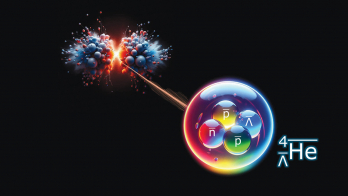
Two new experiments at CERN, ALPHA-g and GBAR, have begun campaigns to check whether antimatter falls under gravity at the same rate as matter.
The gravitational behaviour of antimatter has never been directly probed, though indirect measurements have set limits on the deviation from standard gravity at the level of 10–6 (CERN Courier January/February 2017 p39). Detecting even a slight difference between the behaviour of antimatter and matter with respect to gravity would mean that Einstein’s equivalence principle is not perfect and could have major implications for a quantum theory of gravity.
ALPHA-g, a close model of the ALPHA experiment, combines antiprotons from CERN’s Antiproton Decelerator (AD) with positrons from a sodium-22 source and traps the resulting antihydrogen atoms in a vertical magnetic trap about 2 m tall. To measure their free-fall, the field is switched off so that the atoms fall under gravity and the position where the antiatoms annihilate with normal matter allows the rate to be determined precisely.
GBAR adopts a similar approach but takes antiprotons from the new and lower-energy ELENA ring attached to the AD (CERN Courier December 2016 p16) and combines them with positrons from a small linear accelerator to make antihydrogen ions. Once a laser has stripped all but one positron, the neutral antiatoms will be released from the trap and allowed to fall from a height of 20 cm.
ALPHA-g began taking beam on 30 October, while ELENA has been delivering beam to GBAR since the summer, allowing the collaboration to perfect the beam-delivery system. Both experiments are being commissioned before CERN’s accelerators are shut down on 10 December for a two-year period. The ALPHA-g team hopes to be able to gather enough data during this short period to make a first measurement of antihydrogen in free fall, while the brand new GBAR experiment aims to make a first measurement when antiprotons are back in the machine in 2021. A third experiment at the AD hall, AEgIS, which has been in operation for several years, is also measuring the effect of gravity on antihydrogen using yet another approach, based on a beam of antihydrogen atoms. AEgIS is also hoping to produce its first antihydrogen atoms this year.
So far, most efforts at the AD have focused on looking for charge–parity–time violation by studying the spectroscopy of antihydrogen and comparing it with that of hydrogen (CERN Courier March 2018 p30). This latest round of experiments opens a new avenue in antimatter exploration.








